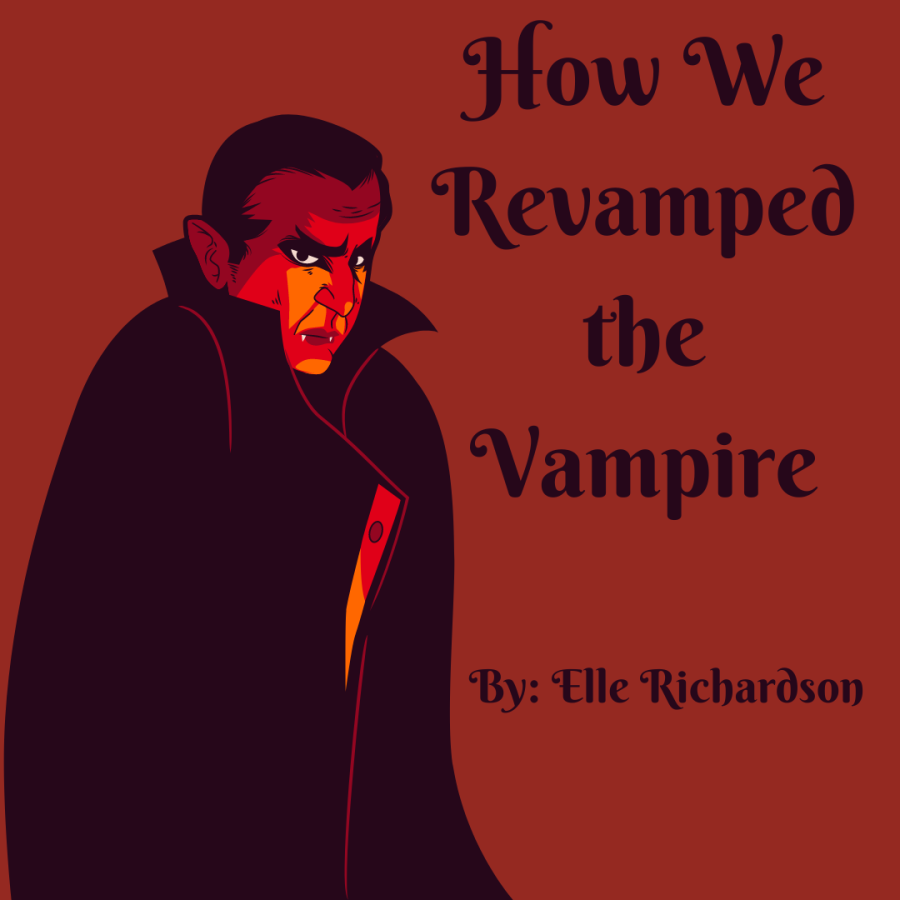How We Revamped the Vampire
In this article, Elle Richardson explores the history behind Vampires.
October 27, 2022
Cloaked, pale, and fanged, vampires have an iconic persona in modern society, especially during Halloween. Yet much of our more modern vampire stereotypes are actually rooted in scientific misconceptions of the past.
The idea of vampires, like many other Halloween icons, originated in Europe. Europeans were paranoid that the dead would come back to haunt them. In the case of vampires, they feared this would be through the dead’s corpse. The most realistic and widely-accepted tale of why vampires were believed to be real is the poor understanding of decomposition.
During the natural process of decomposition, a corpse’s skin shrinks. This makes its teeth and fingernails look longer after the person has died. Fluid from the body can also leak from the nose and mouth. This fluid, known as ‘purge fluid’, looks very similar to blood. People in the past thought that since this was ‘blood’ coming from the mouths of the corpses, the corpses had been feasting on the living. The misunderstanding of how diseases spread also led to the idea of vampires.
Europeans at the time took a lot of proactive actions to stop the wrath of vampires. A skull from the 1600’s was found in Venice with a brick in its mouth. This was an attempt to stop the supposed vampire from eating people. In Germany, the belief that vampires ate their coffins after death was more common. Yet this changed with the outbreak of the Black Plague. Protestant theologists accused vampires of cursing the surviving members of a family affected by the plague. In this manuscript, titled “On the Chewing Dead”, it was possible to stop a vampire from hurting humans by stuffing its mouth with dirt. For extra strength, one could put a coil and stone in for good measure. This would, theoretically, not allow the vampire to eat and it would starve to death. They also thought that smell was what had driven the plague, leading to the belief that garlic hurt vampires.

As the plague faded out of Europe, the fear of vampires did as well. This was hastened by the leaders of both the church and state in Europe at the time. Yet the paranoia still held strong undertones in the more rural or underdeveloped parts of the continent. Many believed they weren’t visible due to their fear of sunlight. Their inability to see their reflections came from the belief that vampires could not interact with any pure metals. As mirrors were lined with silver back then, vampires couldn’t use them. These undertones also carried over to the Western hemisphere. When the more impoverished citizens of Europe came to the Americas, they brought with them their folklore. Unfortunately, the practices involved with said folklore were often damaging and occasionally dangerous.
The most famous ‘vampire’ case in American history took place in 1892. At this time, the country was ravaged by the tuberculosis epidemic. One unfortunate victim to this was a 19 year old girl by the name of Mercy Brown. By the time she succumbed to the disease, her mother and sisters had already passed away and her brother, Edwin Brown, was sick. The surrounding members of the community blamed the dead female members of Edwin’s family for cursing him from beyond the grave. In order to put an end to this, the corpse of Mercy Brown was exhumed. Upon further inspection the people found blood in her mouth and heart, which they interpreted as evidence of her vampirism. They cremated her heart and fed them to Edwin in the form of a potion. Despite their efforts, he died in a matter of months. This cremation of the heart and turning it into a potion was the most common anti-vampire ritual.
After the paranoia of vampires subsided, literary works featuring vampires became popular. The first of these was a short story by John William Polidori written in 1819, titled “The Vampyre”. In this story, a man is killed while traveling Europe but is later seen alive and well as a vampire. One of the most influential pieces of vampire literature is Carmilla, a 1872 novel. It features a lesbian vampire by the name of Carmilla and her victim, Laura. The most famous vampire work from this period is the iconic novel Dracula, written by 1897. It is about the vampire Dracula’s wrong-doings towards society and his persecutor, Van Helsing. This novel helped shape the modern vampire that we see in pop culture today.

Dracula has been adapted into numerous films. This is where the modern image of the vampire came to play. Portrayed by famous actor Bela Lugosi, Dracula stole the screen and entranced audiences across the country. Due to such an impactful part in silent films, Lugosi’s character Dracula reappeared numerous times in modern films, as does the vampire character. The most famous depiction of vampires in recent times has been in the film series Twilight, which differs greatly from the original idea of vampires.
Regardless of how they are portrayed, vampires have been involved in our culture since they were first dreamt up all those years ago. Now that we no longer fear the idea of them, they are immortalized in our art and literature. And every Halloween, we see ‘vampires’ roaming around. But instead of hunting for human flesh, they scourge the streets for sweets.








